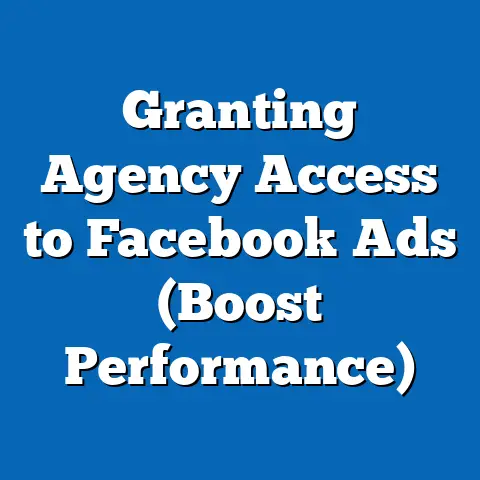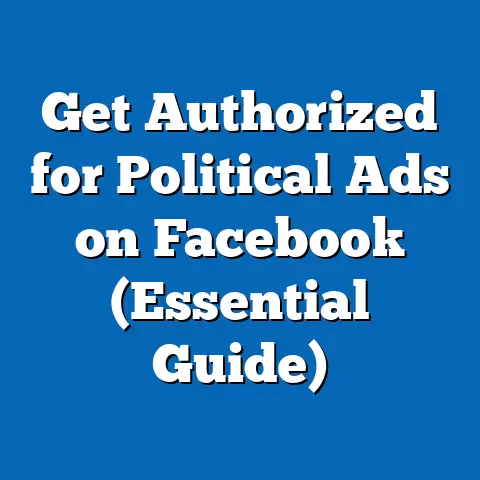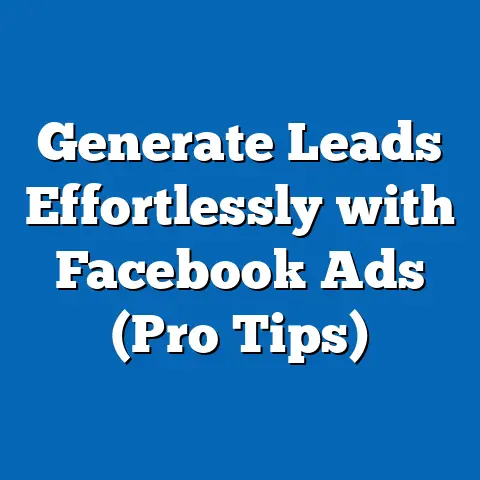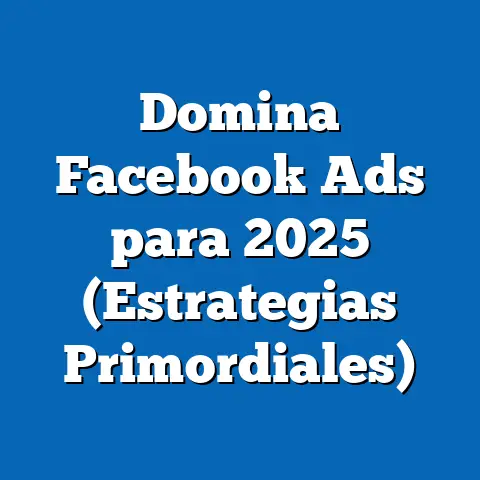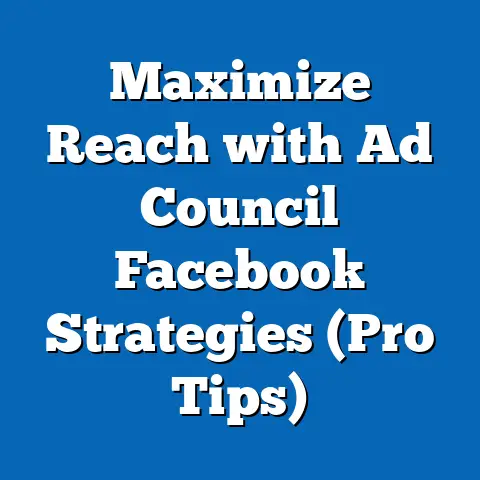Master Facebook Ads Cost Per Conversion (Pro Strategies)
In an era where sustainability has become a cornerstone of business strategy, digital marketing—particularly platforms like Facebook—must adapt to prioritize long-term value over short-term gains. Sustainability, in this context, refers to creating advertising campaigns that are not only cost-effective but also ethically sound, resource-efficient, and aligned with consumer expectations for transparency and social responsibility. As businesses navigate the complexities of digital advertising, understanding how to optimize Facebook Ads’ cost per conversion (CPC) while adhering to sustainable practices is critical for enduring success.
Section 1: Sustainability in Digital Marketing – Defining Characteristics and Importance
Sustainability in digital marketing transcends mere environmental considerations; it encompasses economic, social, and ethical dimensions. A sustainable campaign prioritizes long-term customer relationships over fleeting clicks, minimizes wasteful ad spend, and respects user privacy while delivering value. Key characteristics include transparency in messaging, ethical targeting practices, and the use of data analytics to reduce inefficiencies.
Economically, sustainable digital marketing focuses on maximizing return on investment (ROI) by optimizing metrics like cost per conversion. Socially, it involves creating content that resonates authentically with audiences, avoiding manipulative tactics. Ethically, it requires adherence to data protection regulations like GDPR and a commitment to inclusivity in advertising narratives.
The importance of sustainability in this field cannot be overstated. With growing consumer awareness, brands that fail to adopt sustainable practices risk alienating their audience. A 2021 Nielsen report found that 73% of global consumers are willing to change their consumption habits to reduce environmental impact, and this sentiment extends to how they perceive digital ads. Thus, sustainability is not just a moral imperative but a strategic necessity for maintaining relevance.
Section 2: Historical Context of Digital Advertising and Sustainability
The evolution of digital advertising mirrors broader societal shifts toward sustainability. In the late 1990s and early 2000s, the advent of banner ads and early pay-per-click (PPC) models on platforms like Google marked the beginning of online advertising. During this period, the focus was on volume—maximizing impressions and clicks with little regard for efficiency or user experience.
The launch of Facebook in 2004, followed by its advertising platform in 2007, revolutionized digital marketing by introducing targeted ads based on user demographics and interests. However, this era also saw rampant issues like ad fatigue, privacy scandals (e.g., the 2018 Cambridge Analytica incident), and unsustainable “spray and pray” tactics that prioritized quantity over quality. These events prompted a backlash, with consumers and regulators demanding greater accountability.
By the 2010s, sustainability emerged as a key concern. The introduction of stricter data privacy laws and consumer pushback against intrusive ads forced platforms like Facebook to refine their algorithms and offer more transparent advertising tools. Today, sustainability in digital advertising is shaped by historical lessons—brands must balance profitability with ethical practices to build trust. This historical trajectory underscores the need for strategies that optimize metrics like cost per conversion without compromising long-term credibility.
Section 3: Societal Implications of Sustainable Digital Marketing
The societal impact of sustainable digital marketing is profound, influencing consumer behavior, corporate accountability, and technological innovation. At the consumer level, sustainable advertising fosters trust by prioritizing authenticity and relevance over bombardment. For instance, targeted Facebook Ads that respect user preferences can enhance engagement while reducing the annoyance of irrelevant content.
On a corporate level, adopting sustainable practices in digital marketing aligns with broader corporate social responsibility (CSR) goals. Companies that minimize ad waste and respect data privacy are more likely to build loyal customer bases. A 2022 Edelman Trust Barometer report revealed that 60% of consumers trust brands that demonstrate social and environmental responsibility, a trend that extends to digital interactions.
Technologically, the push for sustainability drives innovation in ad platforms. Facebook’s shift toward machine learning-driven ad optimization and privacy-focused tools (like the 2021 iOS 14.5 update impacting tracking) reflects a societal demand for ethical tech. However, these changes also challenge marketers to adapt, making cost per conversion optimization more complex yet essential for sustainable success.
Section 4: Understanding Facebook Ads Cost Per Conversion
Cost per conversion (CPC) is a critical metric in digital advertising, representing the average cost incurred for each desired action—be it a purchase, sign-up, or download—resulting from a Facebook Ad campaign. Unlike cost per click (CPC in a different context), which measures the cost of each click on an ad, cost per conversion focuses on the end result, making it a more meaningful indicator of campaign effectiveness. Mastering this metric is central to sustainable advertising, as it ensures resources are allocated efficiently.
Several factors influence cost per conversion on Facebook, including audience targeting, ad creative quality, bidding strategy, and industry competition. For instance, highly competitive sectors like e-commerce or finance often face higher CPCs due to increased demand for ad space. According to a 2023 WordStream report, the average cost per conversion across industries on Facebook is approximately $21, though this varies widely based on niche and campaign goals.
The challenge lies in balancing low CPC with high-quality conversions. A low cost per conversion is meaningless if the resulting actions do not translate into long-term value (e.g., one-time purchases versus repeat customers). This is where sustainable strategies come into play—focusing on meaningful engagement rather than short-term wins.
Section 5: Pro Strategies to Optimize Facebook Ads Cost Per Conversion
Achieving a low cost per conversion while maintaining sustainability requires a blend of data-driven tactics and ethical considerations. Below are professional strategies to master Facebook Ads CPC, grounded in both quantitative insights and qualitative best practices. These approaches are designed to maximize ROI while aligning with sustainable digital marketing principles.
5.1 Leverage Advanced Audience Targeting
Facebook’s robust targeting options allow advertisers to reach highly specific audiences, reducing wasted ad spend. Use tools like Custom Audiences to retarget website visitors or past customers, as these groups are more likely to convert at a lower cost. Additionally, Lookalike Audiences can expand reach by targeting users similar to your best-performing customers.
Data from Facebook’s own case studies shows that campaigns using Custom Audiences often see a 30-50% reduction in cost per conversion compared to broad targeting. However, ensure compliance with privacy regulations by obtaining explicit consent for data usage. Sustainable targeting prioritizes relevance and respect for user boundaries over aggressive data collection.
5.2 Optimize Ad Creative for Engagement
Ad creative—images, videos, copy, and calls-to-action (CTAs)—plays a pivotal role in conversion rates. High-quality, visually appealing ads with clear messaging tend to lower CPC by improving click-through rates (CTR) and relevance scores. Test multiple ad variations using A/B testing to identify what resonates best with your audience.
For sustainability, focus on authentic storytelling rather than clickbait. A 2022 study by Hootsuite found that ads with genuine, value-driven content achieve 25% higher engagement rates. This approach not only reduces CPC but also builds long-term brand trust.
5.3 Implement Smart Bidding Strategies
Facebook offers several bidding options, such as cost cap, bid cap, and lowest cost, to control ad spend. For cost per conversion optimization, use cost cap bidding to set a maximum amount you’re willing to pay per conversion while allowing the algorithm to maximize results within that limit. This prevents overspending and aligns with sustainable budgeting.
Regularly monitor and adjust bids based on performance data. According to a 2023 report by Social Media Examiner, campaigns that adjust bids weekly can reduce CPC by up to 20%. Combine this with a focus on high-value conversions to ensure efficiency.
5.4 Utilize Facebook Pixel for Conversion Tracking
The Facebook Pixel is a powerful tool for tracking user behavior and measuring conversions accurately. By installing the Pixel on your website, you can track specific actions (e.g., purchases, form submissions) and optimize campaigns for those events. This data-driven approach minimizes guesswork and reduces CPC by focusing on what works.
From a sustainability perspective, accurate tracking prevents over-investment in underperforming campaigns, conserving resources. However, transparency is key—inform users about data collection practices to maintain trust. Post-iOS 14.5 updates, prioritize first-party data strategies to adapt to privacy changes.
5.5 Focus on Retargeting and Funnel Optimization
Retargeting campaigns, which target users who have previously interacted with your brand, consistently yield lower CPCs due to higher intent. Pair this with a well-structured sales funnel—awareness, consideration, and conversion stages—to guide users toward action without excessive ad spend.
Sustainability in funnel optimization means avoiding aggressive upselling that alienates users. Instead, provide value at each stage through educational content or personalized offers. A 2021 Shopify study found that retargeting campaigns combined with funnel optimization can lower CPC by 40% while improving customer retention.
5.6 Monitor and Reduce Ad Fatigue
Ad fatigue occurs when users see the same ad too often, leading to decreased engagement and higher CPC. Use Facebook’s frequency metrics to monitor how often ads are shown to the same user, and refresh creatives regularly to maintain interest. Limiting ad frequency to 1-2 impressions per week per user can prevent fatigue, according to a 2023 AdEspresso analysis.
This strategy supports sustainability by ensuring ads remain relevant and non-intrusive. It also encourages creativity in campaign design, fostering a positive user experience over time.
5.7 Align Campaigns with Seasonal and Cultural Trends
Timing plays a significant role in cost per conversion. Aligning campaigns with seasonal trends (e.g., holidays) or cultural events can increase relevance and conversion rates, lowering CPC. Use Facebook’s Insights tool to identify peak engagement times for your audience and schedule ads accordingly.
Sustainability here means respecting cultural sensitivities and avoiding exploitative messaging during significant events. A thoughtful approach not only reduces costs but also enhances brand perception.
Section 6: Comparing Generational Responses to Facebook Ads
Generational differences play a crucial role in how audiences respond to Facebook Ads, impacting cost per conversion. Baby Boomers (born 1946-1964), often less tech-savvy, may require simpler ad designs and clear CTAs, while valuing trust and authenticity in messaging. Their CPC can be higher due to lower engagement rates with digital platforms.
Generation X (born 1965-1980) tends to balance skepticism with practicality, responding well to value-driven offers but requiring consistent follow-up for conversions. Millennials (born 1981-1996), a key demographic on Facebook, prioritize social impact and personalized content, often yielding lower CPCs when ads align with their values. Gen Z (born 1997-2012), though less dominant on Facebook, demands authenticity and visual storytelling, with higher CPCs if ads fail to capture attention quickly.
A 2022 Pew Research Center study highlights that Millennials and Gen Z are more likely to engage with sustainable and purpose-driven campaigns, influencing long-term CPC trends. Marketers must tailor strategies to these nuances, avoiding one-size-fits-all approaches. Sustainable advertising respects these differences, ensuring relevance across generations.
Section 7: Technological, Economic, Social, and Cultural Influences on CPC
Technological advancements, such as Facebook’s AI-driven ad optimization and privacy updates, directly impact cost per conversion by altering targeting capabilities. Economically, fluctuations in ad auction competition—driven by industry trends or global events—can raise or lower CPC. For instance, CPC often spikes during holiday seasons due to increased demand.
Socially, consumer expectations for ethical advertising influence engagement rates. Ads perceived as intrusive or irrelevant result in higher CPCs due to low CTRs. Culturally, regional differences in values and communication styles necessitate localized campaigns to maintain efficiency.
Sustainability ties these factors together by encouraging marketers to adapt to technological constraints, budget wisely during economic shifts, respect social norms, and honor cultural diversity. A holistic approach ensures lower CPCs without compromising ethical standards.
Section 8: Implications for Society, Culture, and the Workplace
Optimizing Facebook Ads cost per conversion with a sustainable lens has far-reaching implications. Societally, it promotes a digital ecosystem where users are treated as partners rather than targets, fostering trust in online interactions. Culturally, it encourages brands to reflect diverse perspectives in their campaigns, reducing stereotypes and enhancing inclusivity.
In the workplace, sustainable CPC strategies demand new skills—data analysis, ethical marketing, and creative storytelling—reshaping job roles in advertising. Companies must invest in training to keep pace with evolving tools and consumer expectations. Moreover, aligning campaigns with sustainability goals can improve employee morale, as workers increasingly seek purpose-driven employers.
Section 9: Forward-Looking Insights and Uncertainties
As digital marketing evolves, mastering Facebook Ads cost per conversion will require continuous adaptation to technological, regulatory, and societal changes. Emerging trends like augmented reality (AR) ads and increased focus on first-party data suggest new opportunities for lowering CPC while maintaining relevance. However, uncertainties remain—potential privacy regulations could further limit targeting options, and economic instability may affect ad budgets.
Sustainability will likely remain a guiding principle, with consumers and regulators pushing for greater accountability. Brands that proactively adopt ethical, efficient strategies will be best positioned to thrive. While the future of CPC optimization is not without challenges, a commitment to value-driven advertising offers a path to enduring success.
Conclusion
Mastering Facebook Ads cost per conversion is not merely a technical endeavor but a strategic one, deeply intertwined with the principles of sustainability. By understanding the historical context of digital advertising, recognizing societal implications, and implementing professional strategies, marketers can achieve low CPCs while building long-term trust and relevance. The journey requires balancing technological innovation with ethical considerations, respecting generational and cultural nuances, and preparing for an uncertain future.
Ultimately, sustainable digital marketing on platforms like Facebook is about creating value—for businesses, consumers, and society at large. As the landscape continues to evolve, those who prioritize efficiency and authenticity in their CPC optimization efforts will not only reduce costs but also contribute to a more responsible digital world.

